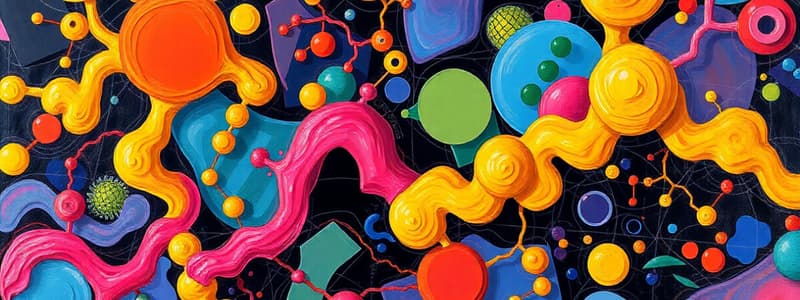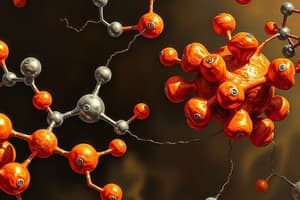Podcast
Questions and Answers
What characteristic defines a monosaccharide?
What characteristic defines a monosaccharide?
- Contains one hydroxyl group and a carboxyl group
- Is made up of amino acids
- Is a polymer of fatty acids
- Has a carbon chain of 3-7 carbons with one aldehyde group (correct)
Which statement accurately describes saturated fatty acids?
Which statement accurately describes saturated fatty acids?
- They contain more hydrogen atoms compared to unsaturated fatty acids (correct)
- They are characterized by having multiple carboxyl groups
- They are liquid at room temperature
- They have at least one double bond in their carbon chain
What is true about triglycerides?
What is true about triglycerides?
- They are primarily used as a source of immediate energy
- They are formed through the process of esterification (correct)
- They are always liquid at room temperature
- They consist of one fatty acid and two glycerol molecules
How does the solubility of fatty acids change with the length of the carbon chain?
How does the solubility of fatty acids change with the length of the carbon chain?
Which type of molecule is glycerol classified as?
Which type of molecule is glycerol classified as?
What differentiates organic compounds from inorganic compounds like Carbon Dioxide?
What differentiates organic compounds from inorganic compounds like Carbon Dioxide?
Which process occurs when monomers are combined to form a polymer?
Which process occurs when monomers are combined to form a polymer?
What type of carbohydrates are ribose and glucose classified as?
What type of carbohydrates are ribose and glucose classified as?
What happens to the valence shells of molecules during dehydration synthesis?
What happens to the valence shells of molecules during dehydration synthesis?
What is the key feature of sugar alcohols as compared to monosaccharides?
What is the key feature of sugar alcohols as compared to monosaccharides?
Which of the following statements about lipids is true?
Which of the following statements about lipids is true?
How does hydrolysis differ from dehydration synthesis?
How does hydrolysis differ from dehydration synthesis?
Which type of bonding is primarily responsible for the stability of lipids?
Which type of bonding is primarily responsible for the stability of lipids?
What form does a glucose molecule take when the hydroxyl group is pointing up?
What form does a glucose molecule take when the hydroxyl group is pointing up?
Which type of glycosidic bond occurs between glucose and fructose to form sucrose?
Which type of glycosidic bond occurs between glucose and fructose to form sucrose?
What distinguishes amylose from amylopectin?
What distinguishes amylose from amylopectin?
Which carbohydrate is known as the main storage form of carbohydrates in animals?
Which carbohydrate is known as the main storage form of carbohydrates in animals?
What type of polymer is cellulose, and what is its primary role?
What type of polymer is cellulose, and what is its primary role?
Which is NOT a characteristic of monosaccharides?
Which is NOT a characteristic of monosaccharides?
What type of bond forms between carbon 1 and carbon 4 in glycogen molecules?
What type of bond forms between carbon 1 and carbon 4 in glycogen molecules?
What primary component do both chitin and cellulose share?
What primary component do both chitin and cellulose share?
What characteristic distinguishes cis fats from trans fats?
What characteristic distinguishes cis fats from trans fats?
Which type of fatty acid is typically liquid at room temperature?
Which type of fatty acid is typically liquid at room temperature?
What component distinguishes phospholipids from triglycerides?
What component distinguishes phospholipids from triglycerides?
How does the presence of unsaturated tails affect phospholipid packing density?
How does the presence of unsaturated tails affect phospholipid packing density?
Which type of lipid is responsible for forming signaling molecules such as testosterone and estradiol?
Which type of lipid is responsible for forming signaling molecules such as testosterone and estradiol?
What role do glycolipids play in biological systems?
What role do glycolipids play in biological systems?
What structure do phospholipids spontaneously form in an aqueous environment?
What structure do phospholipids spontaneously form in an aqueous environment?
What type of bond is primarily formed between the glycerol backbone and fatty acids in triglycerides?
What type of bond is primarily formed between the glycerol backbone and fatty acids in triglycerides?
What is the primary factor determining the physical state of a fatty acid (solid or liquid) at room temperature?
What is the primary factor determining the physical state of a fatty acid (solid or liquid) at room temperature?
Which lipid is made from a lipid chain of alkanes and is known for being hydrophobic?
Which lipid is made from a lipid chain of alkanes and is known for being hydrophobic?
Flashcards are hidden until you start studying
Study Notes
Molecules Overview
- Four primary types of biological molecules:
- Carbohydrates (CHO)
- Lipids (CHOP)
- Proteins (CHONS)
- Nucleic acids (CHONP)
- Cells are predominantly composed of water, which serves as a medium for biochemical reactions.
- Carbohydrates and proteins show variability depending on the cell type, while lipids maintain more consistency.
Organic vs. Inorganic Compounds
- Carbon Dioxide (CO2) is considered inorganic due to the absence of covalent H-C or C-C bonds.
- Structural diagrams like skeletal formulas represent carbon atoms at line ends and vertices.
Polymer Formation
- Monomers combine to form polymers via dehydration reactions, removing water to form covalent bonds.
- Hydrolysis is the reverse process, adding water to break down polymers into monomers.
- Branching is possible in polymers, facilitating energy storage.
Carbohydrates
- Types of carbohydrates:
- Monosaccharides (e.g., glucose, fructose)
- Disaccharides (e.g., sucrose formed from glucose and fructose)
- Oligosaccharides
- Polysaccharides (e.g., glycogen, starch)
- Monosaccharides are polyhydroxy aldehydes or ketones and often exist in ring structures, particularly 5 or 6-membered rings.
- Alpha and beta glucose are isomers distinguished by the orientation of the hydroxyl group.
Polysaccharide Characteristics
- Glycogen serves as short-term carbohydrate storage in animals (found in liver and muscles) and consists of alpha 1-4 and alpha 1-6 linkages.
- Starch, the plant storage form of glucose, has two types:
- Amylose: linear structure (alpha 1-4)
- Amylopectin: branched structure (alpha 1-6 branching)
- Cellulose is the most abundant natural polymer, providing structural support in plants, and is indigestible.
- Chitin, a structural component in exoskeletons and fungal cell walls, is composed of N-acetylglucosamine (NAG) units.
Lipids
- Lipids are organic molecules that are non-polar and insoluble in water.
- Key types of lipids include fatty acids, triglycerides, phospholipids, steroids, waxes, and glycolipids.
- Fatty acids can be saturated (no double bonds) or unsaturated (one or more double bonds).
- Triglycerides consist of glycerol and three fatty acids, serving as the main form of energy storage.
Fat and Oil Properties
- Fats are saturated, solid at room temperature, and have higher melting points (e.g., butter).
- Oils are liquid at room temperature due to the presence of unsaturated fatty acids.
- Cis isomers have bent structures, while trans isomers are straight due to the positioning of hydrogen atoms.
Phospholipids
- Phospholipids contain a hydrophilic phosphate head and hydrophobic fatty acid tails, forming bilayers in aqueous environments essential for cell membranes.
- Their structure influences fluidity; unsaturated tails result in lower melting points and greater fluidity.
Steroids and Other Lipids
- Steroids, such as cholesterol, play critical roles in signaling (e.g., testosterone, estradiol).
- Waxes are hydrophobic lipids used by organisms for protection against dehydration.
- Glycolipids consist of sugars, glycerol, and fatty acids, crucial for immune responses and blood type differentiation.
Lipopolysaccharides
- Found in the cell walls of some bacteria, providing structural integrity and protection.
- Lipid A is linked to pathogenicity through its sugar components, which face the external environment.
Studying That Suits You
Use AI to generate personalized quizzes and flashcards to suit your learning preferences.





